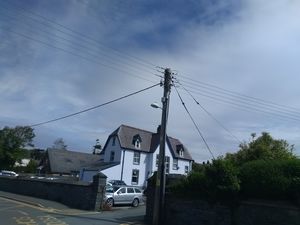Talk:Tag:power=minor line
Insulated
Where I live they are insulated, not uninsulated. Jidanni (talk) 14:26, 5 April 2017 (UTC)
Insulation covering color
One might also want to add a future key to note the color of the plastic skin on the wires (if any.)
Some colors tell drug users "don't bother stealing this cable, as inside in not costly copper, but just aluminum.".
Also one might add a key saying what the wires within are composed of, and their AWG size etc. Jidanni (talk) 15:43, 25 August 2017 (UTC)
ABC photo

A minor power line/cable for 240V local distribution in the UK.
The pole has a minor power line (top-left of image to pole to centre-right of image) of 5 uninsulated conductors. Normally the lowest conductor is neutral, next are three phases and the fifth conductor (if present) is a street lighting feed.
The pole also has an Aerial Bundled Cable (centre-left of image to pole) consisting of an uninsulated neutral and four insulated cores, all encased in outer insulation.
Also visible on the pole are two guy wires (pole to bottom-right of image), a vertical cable leading underground, a street light and two mysterious boxes.
More information about both uninsulated conductors and ABC used for minor distribution in the UK can be seen in this video.
- Above unsigned comment by User:Brian de Ford. Jidanni (talk) 03:19, 31 May 2019 (UTC) Ooops!--Brian de Ford (talk) 17:04, 31 May 2019 (UTC)
Definition vs actual use in database
The definition was changed in 2017 to add more details about possible voltage and use for distribution rather than whether the line is carried by small poles instead of large towers. However, from what I've seen, the pole vs tower distinction seems to still be the main criteria used by most mappers? The definition in the first section of the page is now really long and unnecessarily detailed. Can we tighten this up, and try to match the definition to actual use? See comments on this change: https://wiki.openstreetmap.org/w/index.php?title=Tag%3Apower%3Dminor_line&type=revision&diff=1536016&oldid=1268770 and compare power=line, power=cable, etc. --Jeisenbe (talk) 05:31, 10 December 2019 (UTC)
How was this voltage cut-off determined? "up to 45,000 volts (45 kV), or the highest known standard distribution voltage used in the country or region."
- According to https://es.wikipedia.org/wiki/Red_de_distribución_de_energ%C3%ADa_eléctrica in Colombia the "red de distribución" has a lower level of under 1kV and an upper level of "IV: tensiones de valor mayor a 57.5 kV" - so 60 kV and up (older definition was 62kv and up).
- The Spanish wikipedia article https://es.wikipedia.org/wiki/Transmisión_de_energ%C3%ADa_eléctrica says that "a primera está constituida por la red de reparto... Las tensiones utilizadas están comprendidas entre 25 y 132 kV. .... La segunda etapa la constituye la red de distribución propiamente dicha, con tensiones de funcionamiento de 3 a 30 kV." My translation: "the first consists of the allocation ("subtransmission?") network ... voltages utilized are between 25 kV and 132 kV. The second step consists of the distribution network proper, with voltages from 3 to 30 kv.
- Also this article calls all supports for these transmission and subtransmission lines "towers": "Las torres pueden ser postes simples de madera para las líneas de transmisión pequeñas hasta 46 kilovoltios (kV). Se emplean estructuras de postes de madera en forma de H, para las líneas de 69 a 231 kV. Se utilizan estructuras de acero independientes, de circuito simple, para las líneas de 161 kV o más. Es posible tener líneas de transmisión de hasta 1.000 kV." Translation: "The towers can be simple wooden poles for transmission lines under 46 kV. H-shaped wood pole structures are used for lines from 69 to 231 kV. Steel independent structures are used for lines of 161 kV or more". This suggests that in Spanish (Spain?) a "power=tower" can be a wooden pole, but this also seems to conflate sub-transmission with transmission.
- In Australia, the distribution voltage included 66 kV (and lowest transmission voltage is 132 kv) ( https://www.sa.gov.au/topics/energy-and-environment/electrical-gas-and-plumbing-safety-and-technical-regulation/powerline-safety/identifying-powerlines )
- In Indonesia, the usual primary distribution voltage is 20 kV, with secondary distribution at 220 to 380V ( https://id.wikipedia.org/wiki/Distribusi_tenaga_listrik and http://blog.unnes.ac.id/antosupri/sistem-distribusi-tenaga-listrik/). Proper transmission lines 110 kV and up, with intermediate transmission (subtransmission?) lines at 33kV and 70kV for rural areas. ( https://id.wikipedia.org/wiki/Transmisi_tenaga_listrik )
- It appears that in France there are distribution lines up to 45 kV, but the 90 kV lines are often carried on large poles, though I'm not able to read the primary sources about this.
- In the USA/Canada the primary distribution voltages are 7kV to 14kV, subtransmission voltages are 22 kV to 69 kV or perhaps up to 138 kV (depending on your source), voltages are 150 kV and up are definitely for transmission. ( https://energyeducation.ca/encyclopedia/Electrical_transmission and http://www.science.smith.edu/~jcardell/Courses/EGR220/ElecPwr_HSW.html and https://en.wikipedia.org/wiki/Overhead_power_line and https://en.wikipedia.org/wiki/Electric_power_transmission)
So the "up to 45 kV" number seems odd. The clear things are that 20 kV and under is definitely distribution, and 150 kV and up is definitely transmission, but values from 22 kv to 138 kv are sometimes considered a different class like "subtransmission" or "red de reparto". 66 kV to 90 kV is especially in this gray area. But if the real distinction between power=line and power=minor_line is poles vs towers this becomes less important. --Jeisenbe (talk) 05:47, 14 January 2020 (UTC)
- I think in most countries the final voltage before end user 110-440V is 33kV or less, so it makes sense. I've never seen or heard of a substation transforming 45kV and above down to end user voltages. Only exception I would consider are lines for industrial use, usually 45-275kV. Gazer75 (talk) 06:18, 30 January 2020 (UTC)